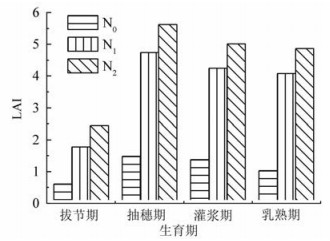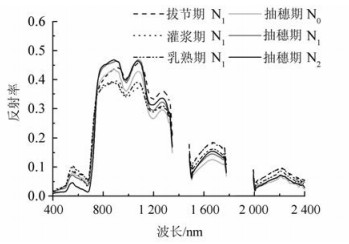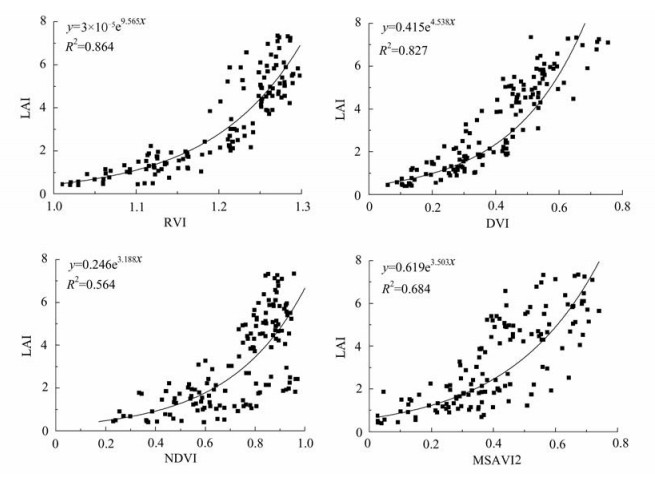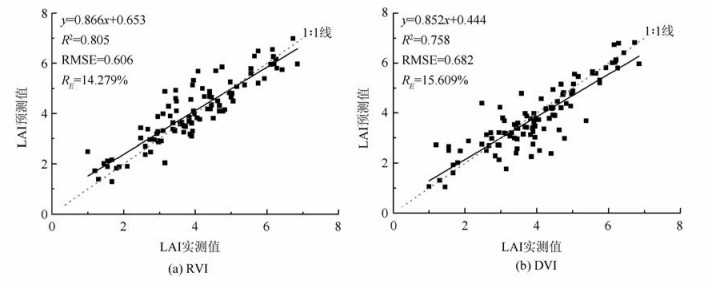Hyperspectral Estimation Model for Predicting LAI of Rice in Ningxia Irrigation Zone
-
摘要: 水稻叶面积指数(leaf area index,LAI)是评价其长势的重要农学参数,高光谱遥感能够实现叶面积指数的快速无损监测。为了寻找反演水稻LAI的最优植被指数,扩展水稻LAI高光谱估测模型的普适性,选取宁夏引黄灌区水稻为研究对象,通过设置不同氮素处理,借助相关分析、回归分析等方法研究高光谱植被指数与水稻LAI之间的定量关系,并通过确立的最优波段组合,构建4种植被指数与水稻LAI的高光谱反演模型。结果表明,水稻LAI在抽穗末期达到最大值,并随氮素水平的增加而增加;水稻冠层原始光谱反射率在400~722 nm和1 990~2 090 nm波段与LAI达到极显著负相关水平,在近红外区域760~1 315 nm与LAI呈极显著正相关。模型检验结果表明,以比值植被指数RVI(850,750)为变量建立的水稻LAI估测模型最佳,研究结果可为水稻LAI的高光谱估测提供地域参考。Abstract: Leaf area index (LAI) is one of the important parameters for evaluating rice growth status. Hyperspectral remote sensing is a new technical approach that can be used to acquire LAI information quickly and nondestructively. This study aims to explore the best vegetation index and monitoring model for rice LAI inversion. This study was carried out in Ningxia irrigation zone, where the rice was planted in different fertilizer level. Then the correlation between vegetation index and LAI was analyzed and four inversion models were constructed for estimating LAI by using correlation analysis and regression analysis. The result revealed that the LAI value increased with the increase of nitrogen level, and it reached a maximum value at booting stage and then drops down. The reflectance of rice canopy at the wavebands 400~722 nm and 1 990~2 090 nm was very significantly negatively correlated with LAI and that of which at near infrared region (760~1 315 nm) was very significantly positively correlated with LAI. The tests with independent dataset suggested that the rice LAI monitoring models with radio vegetation index RVI (850, 750) as the variable could give an accurate LAI estimation. These results provided an insight for monitoring the rice LAI in different regions.
-
Keywords:
- rice /
- leaf area index /
- hyperspectral /
- estimation model /
- Ningxia irrigation region
-
叶面积指数(leaf area index,LAI)是陆地生态系统一个十分重要的结构参数[1],也是作物群体结构的重要量化指标,常被用来进行作物长势判断和产量估测[2, 3]。因此,实时、动态地监测作物LAI状况具有重要意义[4]。传统LAI的地面测定方法(如收获测量法、落叶收集法等)虽然能得到较为准确的LAI值,但这些方法在获取大范围农作物LAI时,存在工作量大、费用高,且对植株本身具有一定的破坏性等缺点。而遥感技术的发展,特别是高光谱遥感技术凭借其高效、非破坏性等优势,为大尺度范围的作物LAI监测提供了有效途径。
高光谱遥感利用植物冠层反射光谱在不同波段的差异,通过构建植被指数来反演LAI[5]。目前,国内外已有不少学者采用不同方法研究了水稻LAI的高光谱反演。文献[6]通过分析不同洪涝胁迫强度下的水稻叶面积指数与冠层高光谱的响应规律,建立了洪涝胁迫下水稻叶面积指数的估测模型。文献[7]认为由调节型归一化植被指数构建的指数模型预测水稻LAI效果最好。还有一些学者借助模糊统计方法(主成分分析或支持向量机等)来提高水稻LAI的估算精度[8, 9]。由于高光谱植被指数受环境、土壤背景及植被本身变化等内外因素的影响,不同地域、不同环境中反演植被LAI的高光谱敏感波段也不尽相同[10, 11],而现有研究中鲜有针对西北地区水稻LAI进行的高光谱遥感监测研究。因此,本文选择宁夏引黄灌区水稻为研究对象,通过设置不同氮素水平,研究水稻LAI与冠层高光谱植被指数之间的相关关系,寻找反演水稻LAI的最佳波段组合,以此来构建估测水稻LAI的高光谱定量化模型,以期为水稻LAI的实时定量监测提供地域性参考,为大面积范围内的水稻长势监测提供依据。
1 材料与方法
1.1 试验设计
田间试验于2014年在宁夏青铜峡市叶盛镇水稻示范基地进行,供试水稻品种为宁粳43号。供试土壤为表绣灌淤土,土壤有机质含量15.8 g·kg-1,全氮含量0.94 g·kg-1,速效氮含量62.2 mg·kg-1,速效磷含量15.94 mg·kg-1,速效钾含量148.06 m。试验选择了4个具有代表性的水稻生育期,进行水稻冠层光谱和叶面积指数的测定。测定与采样时间分别为:7月12日(拔节期),植被特征表现为群体较小,田内有水,稍有裸露的土壤;8月12日(抽穗期),植被盖度接近90%,基本无土壤裸露;8月31日(灌浆期),水稻种子颗粒饱满,植被盖度接近90%;9月17日(乳熟期),稻田内无水,部分叶片开始枯黄,脱落。
试验设0、240、300 3个施氮(纯N)水平(单位为kg·hm-2),分别记为N0、N1、N2。共划分12个小区,小区面积60 m2(10 m×6 m),设4个重复(图 1(a))。氮肥分3次施入,分别为基肥60%、分蘖肥20%、穗肥20%,人为造成无肥、氮肥适中和氮肥过量3种情况。各小区磷、钾施用量相同,纯磷为105 kg·hm-2,纯钾为60 kg·hm-2,全部作基肥。试验使用的肥料为尿素、重过磷酸钙和氯化钾。其他管理措施按当地水稻高产栽培进行。
小区试验用于模型构建,为了扩展模型的普适性,选择贺兰县桂文村5块水稻大田为观测对象(图 1(b)),观测项目及时期同小区试验,用大田独立试验数据对预测模型进行检验。
1.2 冠层光谱与LAI的测定
采用美国SVC(Spectra Vista Corporation)生产的HR-1024i便携式地物光谱仪测定水稻冠层光谱。光谱仪的波段值范围为350~2 500 nm,其中350~1 000 nm光谱采样间隔为1.5 nm,光谱分辨率为3.5 nm;1 000~1 890 nm光谱采样间隔为3.8 nm,光谱分辨率为9.5 nm;1 890~2 500nm光谱采样间隔为2.5 nm,光谱分辨率为6.5 nm。冠层光谱测定选择在天气晴朗、无风或风速很小时进行,时间为10:00~14:00(太阳高度角大于45°)。测量时光谱仪视场角25°,传感器探头垂直向下,距水稻冠层垂直高度约0.7 m,每次采集目标光谱前后都进行参考板校正。对每一水稻小区前、中、后3个位置随机选择3个具有代表性的样本点,对水稻大田分东、西、南、北和中5个方位随机选择5个具有代表性的样点。视场范围内采样重复10次,每次记录5个采样光谱,取平均值作为该样本点的光谱测量值。对每一生育期测得小区样本数36个,大田样本数25个。
LAI的测定与冠层光谱同步,光谱数据测定后,对应于测冠层光谱的位置,采用英国Delta公司的SUNSCAN冠层分析系统(Canopy Analysis System)测定水稻冠层LAI。测量时使SUNSCAN置于水稻冠层下,从垂直于水稻田垄方位开始每隔45°测定一次,每个样本点测定4次,取其算数平均值作为该样本点的LAI。
1.3 数据处理
本试验在水稻的4个关键生育期共测得建模样本数36×4=144个(小区),检验样本数25×4=100个(大田)。在数据分析前利用光谱仪自带的处理软件将采集的水稻冠层光谱数据进行处理并导出,剔除受仪器和外界干扰较大的350~400 nm波段以及3个噪音严重的水汽吸收波段,即1 350~1 480 nm、1 780~1 990 nm和2 400~2 500 nm。剔除后剩余797个数据波段。采用Savitzky-Golay(SG)[12]平滑滤波对光谱数据进行预处理,平滑点数为5。
1.4 研究方法
本文选择以往学者研究中与水稻LAI相关性较好的4个植被指数来反演水稻LAI,包括比值植被指数(RVI)、差值植被指数(DVI)、归一化植被指数(NDVI)以及二次修正土壤调节植被指数(MSAVI2),各植被指数计算公式[13-16]如下:
$$ \begin{array}{l} {\rm{RVI}} = \frac{{\rho {\rm{NIR}}}}{{\rho {\rm{Red}}}}\\ {\rm{DVI}} = \rho {\rm{NIR}}- \rho {\rm{Red}}\\ {\rm{NDVI}} = \frac{{\rho {\rm{NIR}}- \rho {\rm{Red}}}}{{\rho {\rm{NIR}} + \rho {\rm{Red}}}}{\rm{}}\\ {\rm{MSAVI2}} = \frac{1}{2}[(2\rho {\rm{NIR}} + 1)-\\ \sqrt {{{(2\rho + NIR1)}^2}-8(\rho {\rm{NIR}}\rho {\rm{Red}})}] \end{array} $$ 其中,ρNIR为近红外波段反射率;ρRed为红光波段反射率。
通过构建400~2 400 nm之间797个波段的任意两波段组合构成的4个植被指数,寻找反演水稻LAI的最优波段组合。然后以高光谱植被指数为自变量建立水稻LAI的回归模型,最后对模型精度进行评价。以决定系数R2、均方根误差(RMSE)和相对误差(RE)作为精度评价标准,并绘制实测值与模型预测值之间的1:1图。
2 结果分析
2.1 水稻LAI及光谱反射率的变化
如图 2所示,水稻LAI在不同生育期内差异明显。从水稻移栽起,随生育期的推进,由于水稻分蘖数量的增加及单叶面积持续增长,促使LAI不断增加,LAI的增速表现为先快后慢;到抽穗期,虽然无效分蘖死亡,而单叶面积仍然增加,致使LAI达到最大值。从灌浆期开始,叶片已经不能进行较强的光合作用,并且不断将养分向穗部转移,植株下部的叶片开始衰老、枯黄以至干死,使得LAI逐渐减小。
如图 3所示,从拔节期到抽穗期,随着水稻植株的不断生长,叶层增多,LAI不断增加,这使得近红外的反射率逐渐增大,到抽穗期当LAI达到最大值时,近红外的反射率趋向稳定。从灌浆期开始,因叶片向穗部提供大量养分,致使叶片内部组织结构发生变化,LAI开始逐渐下降。到乳熟期,水稻从营养生长转为生殖生长,下部叶片不断衰老、死亡,近红外的反射率也开始逐渐下降,持续到水稻成熟。
在各生育期内,水稻的LAI均随氮素水平的升高而增加(图 2),说明氮素对水稻LAI有较大的影响。这种差异也反映在光谱曲线上(图 3),表现为在近红外波段,水稻冠层光谱反射率随供氮水平的增加而增加,在可见光波段则呈现相反的趋势。
2.2 水稻冠层光谱与LAI的相关性
2.2.1 水稻冠层原始光谱与LAI的相关性
水稻冠层光谱反射率与LAI相关性分析结果如图 4所示,在400~736 nm、1 480~1 780 nm和1 990~2 400 nm共3个波段范围内,水稻冠层光谱反射率与LAI总体呈负相关关系,其中400~722 nm和1 990~2 090 nm波段,负相关性达到极显著水平(99%置信区间,n=144),在663 nm负相关系数最大为-0.727,形成一个波谷,与文献[17]的结果671 nm较为接近;到736 nm附近相关系数迅速接近于0.736~1 350 nm波段区间,冠层高光谱反射率与LAI呈正相关。其中736~760 nm波段,相关系数随着波长的增加而增加,达到0.64,此区域色素对光能的吸收逐渐减弱,而细胞结构对光的反射开始增强。约在940 nm附近,相关系数迅速下降,但下降幅度不大,且具有波动性。近红外区域760~1 315 nm对冠层及叶片结构表现敏感,与LAI的相关性达到了0.01的极显著水平。
2.2.2 高光谱植被指数与LAI的相关性
为了寻找反演水稻LAI植被指数的最优波段组合,将任意两波段组成的4个植被指数分别与LAI作回归分析,得到决定系数R2矩阵图(图 5)。根据4个植被指数的计算公式以及R2矩阵的对称性,其中RVI(图 5(a))与MSAVI2(图 5(b))为全矩阵,而DVI(图 5(c))和NDVI(图 5(d))为三角矩阵。由图 5可见,每个图中均存在一定范围的红色区域(R2>0.8),表示这些波段组合与LAI的相关性达到较高水平。对于4种植被指数,与LAI相关性较高的波段组合范围较接近,均是分布在720~770 nm与700~1 350 nm范围的组合。根据R2最大的原则,选择最佳波段组合来构建反演LAI的植被指数,4个植被指数分别为RVI(850, 750)、MSAVI2(995, 728)、DVI(995, 740)和NDVI(865, 760)。
2.3 基于回归模型的水稻LAI估算
将由最佳波段组合构建的4个植被指数分别与LAI进行线性和非线性拟合,建立水稻LAI的预测模型,结果见表 1。
表 1 估算水稻LAI的高光谱植被指数模型Table 1. Hyperspectral Vegetation Index Estimation Model of LAI for Rice变量 模型 回归方程 R2 F 线性 y=22.954x-24.165 0.754 65.28 指数 y=3×10-5e9.565x 0.864 80.56 RVI 对数 y=26.514lnx-1.404 0.740 60.35 二次多项式 y=92.887x2-194.37x +102.35 0.816 73.62 幂 y=0.355x11.137 0.857 74.54 线性 y =11.511x-1.312 0.806 45.76 指数 y=0.415e4.538x 0.827 72.25 DVI 对数 y=3.295 0lnx+6.640 0.676 20.79 二次多项式 y=8.176x2 + 5.2x-0.301 0.812 65.25 幂 y=10.735x1.412 0.820 50.16 线性 y=7.619x-2.299 0.488 21.36 指数 y=0.246e3.188x 0.564 45.26 NDVI 对数 y=4.244lnx+4.766 0.437 15.27 二次多项式 y=4.221x2+ 8.830x-0.746 0.505 20.16 幂 y=4.831x1.831 0.537 38.25 线性 y=8.614x-0.193 8 0.632 37.69 指数 y=0.619e3.503x 0.684 66.75 MSAVI2 对数 y=1.524lnx+4.964 0.424 25.46 二次多项式 y=4.156x2+ 5.511x+0.237 0.616 28.35 幂 y=5.623x0.715 0.638 55.24 通过比较表 1中各模型的R2和F检验值,得出不同植被指数构建的LAI估算模型中,比值植被指数(RVI)模型的拟合效果最好,R2最小0.740,最大0.864,达到极显著水平;其次为差值植被指数(DVI)模型,最差的是归一化植被指数(NDVI)模型。对4种植被指数而言,不同函数形式的估算模型相比较,最适合的拟合模型为指数模型,其次为幂函数模型,最差的为对数模型。分析其原因,主要是随着水稻的生长发育,叶片之间相互重叠,遮盖越来越严重,LAI与覆盖度之间呈现非线性关系。覆盖度的增加愈来愈缓慢,由此导致冠层光谱在红外波段的反射率增长减缓,LAI与各种植被指数之间呈非线性变换,这与前人的研究结果一致[11]。4种植被指数的最佳估算模型——指数模型的预测效果见图 6。
由图 6可知,不同植被指数在反映LAI变化时差异很大。在水稻生育初期,即当LAI < 3时,4个模型均能较好反映水稻LAI与植被指数的变化关系;随着生育期的推进,到达抽穗后期,即当LAI> 5时,4个模型均出现不同程度的饱和现象。其中RVI模型的总体拟合精度最高,但是后期受到叶绿素含量降低的影响,RVI的敏感度降低,一定程度上造成了拟合度下降。DVI模型总体拟合精度次之,由于DVI对土壤噪声反应敏感,在植被覆盖度较低即土壤噪声较大时拟合精度比RVI模型低;到抽穗期后期由于植被覆盖度升高,相应土壤背景噪声减小,此时的DVI模型对植被的敏感度提高,拟合精度优于RVI模型。另外两个植被指数NDVI和MSAVI2在抽穗后对LAI的预测效果欠佳,NDVI的局限性表现在其饱和度低[18],受土壤背景影响明显,当植被覆盖度高(LAI>3) 时具有较低的敏感度,主要适用于水稻生育早期即植被覆盖度低的时期;MSAVI2虽然较NDVI可以更好地消除土壤背景等对反射光谱造成的影响,但可能丢失部分植被信息,一般适合于植被覆盖度变化较小时的LAI提取。综上所述,RVI和DVI整体表现较好,因此本文选用RVI和DVI为变量建立的回归模型来预测LAI。
2.4 水稻LAI反演精度评价
为了检验由RVI和DVI为变量建立的回归模型在估算水稻LAI时的可靠性和普适性,选择同一时期测得的水稻大田独立数据进行验证。检验结果如图 7所示。
对比发现,以RVI为变量建立的回归模型预测值和实际值之间的一致性较好,预测值和实测值之间的测定系数R2达到0.805,均方根误差RMSE为0.606,估算精度达到85.72%。而DVI估算模型在LAI介于3~6时,模型的大多数预测值较实测值低,这在整体上降低了模型的估测精度。与RVI构建的模型相比,DVI模型的RMSE和RE均高于RVI模型,因此,预测水稻LAI的最优植被指数为RVI。文献[19, 20]在研究水稻冠层光谱反射率与LAI的关系时也发现,RVI与LAI的相关性要高于NDVI和DVI,但用RVI构建的LAI估算模型与本文结果有所差异。通过高光谱手段估算LAI依赖于土壤背景和植被的比例,而水稻的冠层光谱包含植被和部分积水覆盖土壤的混合光谱信息,这是造成差异的主要原因。
3 结语
本文结合宁夏引黄灌区水稻小区及大田试验,通过分析水稻冠层光谱与叶面积指数LAI的相关性,寻找预测水稻LAI的最佳植被指数及预测模型,得到主要结论如下。
水稻不同生育期、不同氮素水平下LAI存在差异,各生育期内LAI均随供氮水平的增加而增加,至抽穗末期达到最大值。LAI的差异导致冠层光谱的反射曲线有所不同,冠层光谱反射率随氮素水平的提高在可见光波段降低,近红外波段升高。
水稻冠层光谱反射率与LAI存在显著相关性,4个高光谱植被指数中,以RVI(850, 750)为参数建立的指数模型对水稻LAI的预测效果最好。
借助高光谱遥感技术进行水稻LAI的估测,受品种、生育期和背景等因素的影响,导致不同学者提出的拟合模型不尽相同,本研究可为不同环境下水稻LAI的估测提供参考。以后的研究中需要加强水稻品种试验,并减少环境和仪器等外界因素的干扰,以实现模型估测精确性和普适性的有效统一。
-
表 1 估算水稻LAI的高光谱植被指数模型
Table 1 Hyperspectral Vegetation Index Estimation Model of LAI for Rice
变量 模型 回归方程 R2 F 线性 y=22.954x-24.165 0.754 65.28 指数 y=3×10-5e9.565x 0.864 80.56 RVI 对数 y=26.514lnx-1.404 0.740 60.35 二次多项式 y=92.887x2-194.37x +102.35 0.816 73.62 幂 y=0.355x11.137 0.857 74.54 线性 y =11.511x-1.312 0.806 45.76 指数 y=0.415e4.538x 0.827 72.25 DVI 对数 y=3.295 0lnx+6.640 0.676 20.79 二次多项式 y=8.176x2 + 5.2x-0.301 0.812 65.25 幂 y=10.735x1.412 0.820 50.16 线性 y=7.619x-2.299 0.488 21.36 指数 y=0.246e3.188x 0.564 45.26 NDVI 对数 y=4.244lnx+4.766 0.437 15.27 二次多项式 y=4.221x2+ 8.830x-0.746 0.505 20.16 幂 y=4.831x1.831 0.537 38.25 线性 y=8.614x-0.193 8 0.632 37.69 指数 y=0.619e3.503x 0.684 66.75 MSAVI2 对数 y=1.524lnx+4.964 0.424 25.46 二次多项式 y=4.156x2+ 5.511x+0.237 0.616 28.35 幂 y=5.623x0.715 0.638 55.24 -
[1] Chen J M, Cihlar J. Retrieving Leaf Area Index of Boreal Conifer Forests Using Landsat TM Images[J]. Remote Sensing of Environment, 1996, 55(2):153-162 doi: 10.1016/0034-4257(95)00195-6
[2] 浦瑞良, 宫鹏.高光谱遙感及其应用[M].北京:高等教育出版社, 2000:1-254 Pu Ruiliang, Gong Peng. Hyperspectral Remote Sensing and Its Applications[M]. Beijing:Higher Education Press, 2000:1-254
[3] 王春梅, 顾行发, 余涛, 等.农田春小麦叶面积指数和覆盖度时空变异性研究[J].农业机械学报, 2014, 45(8):254-261 doi: 10.6041/j.issn.1000-1298.2014.08.041 Wang Chunmei, Gu Xingfa, Yu Tao, et al. Spatial and Temporal Variability of Spring Wheat Leaf Area Index and Coverage in Northwest China[J].Transactions of the Chinese Society for Agricultural Machinery, 2014, 45(8):254-261 doi: 10.6041/j.issn.1000-1298.2014.08.041
[4] Li Xinchuan, Zhang Youjing, Bao Yansong, et al. Exploring the Best Hyperspectral Features for LAI Estimation Using Partial Least Squares Regression[J].Remote Sensing, 2014, 6(7):6221-6241 doi: 10.3390/rs6076221
[5] Wang F M, Huang J F, Zhou Q F, et al. Optimal Waveband Identification for Estimation of Leaf Area Index of Paddy Rice[J]. J. Zhejiang Univ. Sci. B, 2008, 9(12):953-963 doi: 10.1631/jzus.B0820211
[6] 徐鹏, 顾晓鹤, 孟鲁闽, 等.洪涝胁迫的水稻叶面积指数变化及其光谱响应研究[J].光谱学与光谱分析, 2013, 33(12):3298-3302 doi: 10.3964/j.issn.1000-0593(2013)12-3298-05 Xu Peng, Gu Xiaohe, Meng Lumin, et al. Change of LAI and Spectral Response for Rice Under Flood and Waterlogging Stress[J].Spectroscopy and Spectral Analysis, 2013, 33(12):3298-3302 doi: 10.3964/j.issn.1000-0593(2013)12-3298-05
[7] 刘占宇, 黄敬峰, 王福民, 等.估算水稻叶面积指数的调节型归一化植被指数[J].中国农业科学, 2008, 41(10):3350-3356 doi: 10.3864/j.issn.0578-1752.2008.10.057 Liu Zhanyu, Huang Jingfeng, Wang Fumin, et al. Adjusted-Normalized Difference Vegetation Index for Estimating Leaf Area Index of Rice[J].Scientia Agricultura Sinica, 2008, 41(10):3350-3356 doi: 10.3864/j.issn.0578-1752.2008.10.057
[8] 杨燕, 田庆久.高光谱反演水稻叶面积指数的主成分分析法[J].国土资源遥感, 2007(3):47-50, 61 doi: 10.6046/gtzyyg.2007.03.11 Yang Yan, Tian Qingjiu. Principal Component Analysis Method for Retrieving Leaf Area Index of Rice from Hyperspectral Data[J]. Remote Sensing for Land & Resources, 2007(3):47-50, 61 doi: 10.6046/gtzyyg.2007.03.11
[9] 杨晓华, 黄敬峰, 王秀珍, 等.基于支持向量机的水稻叶面积指数高光谱估算模型研究[J].光谱学与光谱分析, 2008, 28(8):1837-1841 http://www.cnki.com.cn/Article/CJFDTOTAL-GUAN200808039.htm Yang Xiaohua, Huang Jingfeng, Wang Xiuzhen, et al. The Estimation Model of Rice Leaf Area Index Using Hyperspectral Data Based on Support Vector Machine[J]. Spectroscopy and Spectral Analysis, 2008, 28(8):1837-1841 http://www.cnki.com.cn/Article/CJFDTOTAL-GUAN200808039.htm
[10] Nguy-Robertson A L, Peng Y, Gitelson A A, et al. Estimating Green LAI in Four Crops:Potential of Determining Optimal Spectral Bands for a Universal Algorithm[J]. Agricultural and Forest Meteorology, 2014(192-193):140-148
[11] Haboudane D. Hyperspectral Vegetation Indices and Novel Algorithms for Predicting Green LAI of Crop Canopies:Modeling and Validation in the Context of Precision Agriculture[J]. Remote Sensing of Environment, 2004, 90(3):337-352 doi: 10.1016/j.rse.2003.12.013
[12] Ruffin C, King R L, Younan N H. A Combined Derivative Spectroscopy and Savitzky-Golay Filtering Method for the Analysis of Hyperspectral Data[J].GIScience & Remote Sensing, 2008, 45(1):1-15
[13] Pearson R L, Miller L D. Remote Mapping of Standing Crop Biomass for Estimation of the Productivity of the Short-Grass Prairie, Pawnee National Grassland, Colorado[C]. The 8th International Symposium on Remote Sensing of the Environment Ann Arbor, Michigan, 1972
[14] Jordan C F. Derivation of Leaf Area Index from Quality of Light on the Forest Floor[J]. Ecology, 1969, 50(4):663-666 doi: 10.2307/1936256
[15] Rouse J W, Haas R H, Schell J A. Monitoring the Vernal Advancement and Retrogradation (Greenwave Effect) of Natural Vegetation[M]. College Station:Texas A and M University Press, 1974
[16] Qi J, Chehbouni A, Huete A R, et al. A Modified Soil Adjusted Vegetation Index[J]. Remote Sensing of Environment, 1994, 48(2):119-126 doi: 10.1016/0034-4257(94)90134-1
[17] 王秀珍, 黄敬峰, 李云梅, 等.水稻叶面积指数的高光谱遥感估算模型[J].遥感学报, 2004, 8(1):81-88 doi: 10.11834/jrs.20040113 Wang Xiuzhen, Huang Jingfeng, Li Yunmei, et al. The Study on Hyperspectral Remote Sensing Estimation Models About LAI of Rice[J]. Journal of Remote Sensing, 2004, 8(1):81-88 doi: 10.11834/jrs.20040113
[18] Carlson T N, Ripley D A. On the Relation Between NDVI, Fractional Vegetation Cover, and Leaf Area Index[J]. Remote Sensing of Environment, 1997, 62(3):241-252 doi: 10.1016/S0034-4257(97)00104-1
[19] Shibayama M, Akiyama T. Seasonal Visible, Near-Infrared and Mid-Infrared Spectra of Rice Canopies in Relation to LAI and Above-Ground Dry Phytomass[J]. Remote Sensing of Environment, 1989, 27(2):119-127 doi: 10.1016/0034-4257(89)90011-4
[20] 薛利红, 曹卫星, 罗卫红, 等.光谱植被指数与水稻叶面积指数相关性的研究[J].植物生态学报, 2004, 28(1):47-52 doi: 10.17521/cjpe.2004.0007 Xue Lihong, Cao Weixing, Luo Weihong, et al. Relationship Between Spectral Vegetation Indices and LAI in Rice[J]. Acta Phytoecologica Sinica, 2004, 28(1):47-52 doi: 10.17521/cjpe.2004.0007
-
期刊类型引用(10)
1. 曾广泉,马韬,张孟希,戴妍,陈凯文,丁继辉,俞双恩,王中文. 基于无人机多光谱影像的不同施氮量水稻LAI反演方法研究. 江苏农业科学. 2024(20): 41-48 .  百度学术
百度学术
2. 高钰琪,许桂玲,冯跃华,王晓珂,任红军,由晓璇,韩志丽,李家乐. 基于冠层高光谱植被指数的水稻产量预测模型研究. 中国稻米. 2023(05): 38-44 .  百度学术
百度学术
3. 彭晓伟,张爱军,王楠,赵丽,杨晓楠. 高光谱技术在土壤及适种作物的研究进展. 遥感信息. 2022(01): 32-39 .  百度学术
百度学术
4. 王晓珂,刘婷婷,许桂玲,冯跃华,彭金凤,李杰,罗强鑫,韩志丽,卢苇,PHONENASAY Somsana. 基于冠层高光谱遥感的杂交水稻植被指数氮素营养诊断模型. 中国稻米. 2021(03): 21-29 .  百度学术
百度学术
5. 王浩淼,宋苗语,李翔,扈朝阳,鲁任翔,王翔,马会勤. 无人机高光谱遥感监测葡萄长势与缺株定位. 园艺学报. 2021(08): 1626-1634 .  百度学术
百度学术
6. 刘雅婷,龚龑,段博,方圣辉,彭漪. 多时相NDVI与丰度综合分析的油菜无人机遥感长势监测. 武汉大学学报(信息科学版). 2020(02): 265-272 .  百度学术
百度学术
7. 陈晓凯,李粉玲,王玉娜,史博太,侯玉昊,常庆瑞. 无人机高光谱遥感估算冬小麦叶面积指数. 农业工程学报. 2020(22): 40-49 .  百度学术
百度学术
8. 落莉莉,常庆瑞,武旭梅,杨景,李粉玲,王琦. 夏玉米叶片光合色素含量高光谱估算. 干旱地区农业研究. 2019(04): 178-183 .  百度学术
百度学术
9. 张良培,刘蓉,杜博. 使用量子优化算法进行高光谱遥感影像处理综述. 武汉大学学报(信息科学版). 2018(12): 1811-1818 .  百度学术
百度学术
10. 李亚妮,鲁蕾,刘勇. 基于PROSAIL模型的水稻田缨帽三角-叶面积指数模型及其应用. 应用生态学报. 2017(12): 3976-3984 .  百度学术
百度学术
其他类型引用(17)





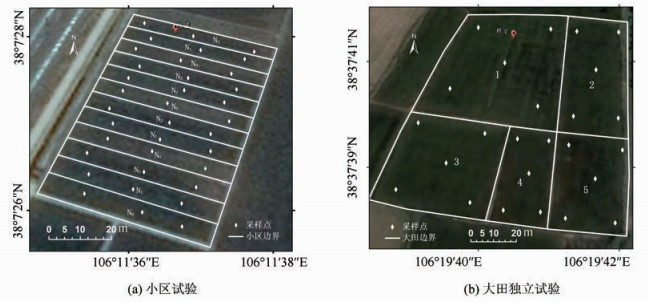
 下载:
下载:
